It’s a tough time in the market right now.
Mr. Market is in some kind of mood.
Volatility has cranked up, and plenty of stocks are down heavily this year.
But you know what?
The dividend payments from great businesses are generally up this year.
That’s right.
You can find hundreds of US-listed stocks that have raised dividends each year for at least the last five consecutive years on the Dividend Champions, Contenders, and Challengers list.
When I say “each year”, that includes this year.
While stock prices are at the whim of an emotional stock market, dividends are at the whim of businesses and business results.
The latter is far more reliable and less volatile.
This is a major reason why I only invest in high-quality dividend growth stocks.
 These stocks represent equity in world-class businesses that pay reliable, rising dividends.
These stocks represent equity in world-class businesses that pay reliable, rising dividends.
And those are funded by reliable, rising profit.
No matter what’s going on in the world or stock market, the world keeps turning and society keeps moving.
Products and/or services continue to get sold, day in and day out, often at slowly rising prices.
Steadily growing dividend income offers great comfort to a long-term investor, especially when the market, like it is now, gets a bit wobbly.
After all, when you rely purely on the dividend income that your portfolio is generating (and not resorting to selling shares) for income and paying the bills, market volatility is really of little concern.
This rationale has focused me on high-quality dividend growth stocks as I’ve gone about building the FIRE Fund over the last 10+ years.
That’s my real-life, real-money portfolio, and it produces enough five-figure passive dividend income for me to live off of.
Indeed, I’ve been in the super fortunate position of being able to live off of dividend income for a while now, even being able to retire in my early 30s.
 My Early Retirement Blueprint recounts how I was able to accomplish that.
My Early Retirement Blueprint recounts how I was able to accomplish that.
Of course, routinely buying high-quality dividend growth stocks has been key to my success.
But so has valuation at the time of any investment.
Whereas price is what you pay, value is what you actually get for your money.
An undervalued dividend growth stock should provide a higher yield, greater long-term total return potential, and reduced risk.
This is relative to what the same stock might otherwise provide if it were fairly valued or overvalued.
Price and yield are inversely correlated. All else equal, a lower price will result in a higher yield.
That higher yield correlates to greater long-term total return potential.
This is because total return is simply the total income earned from an investment – capital gain plus investment income – over a period of time.
Prospective investment income is boosted by the higher yield.
But capital gain is also given a possible boost via the “upside” between a lower price paid and higher estimated intrinsic value.
And that’s on top of whatever capital gain would ordinarily come about as a quality company naturally becomes worth more over time.
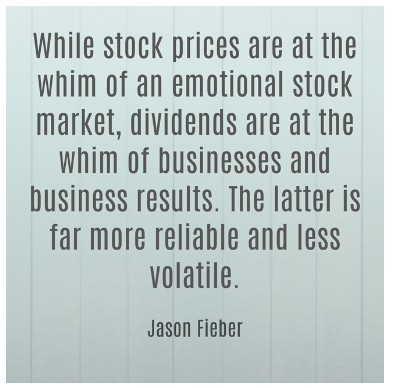 These dynamics should reduce risk.
These dynamics should reduce risk.
Undervaluation introduces a margin of safety.
This is a “buffer” that protects the investor against unforeseen issues that could detrimentally lessen a company’s fair value.
It’s protection against the possible downside.
Sticking to buying and holding undervalued high-quality dividend growth stocks makes it easier to ride out market volatility with those steady, growing dividends, all while also building serious wealth over the long term.
Now, this does assume that one understands valuation and can identify undervaluation.
But it’s not that difficult.
My colleague Dave Van Knapp put together Lesson 11: Valuation in order to help anyone who needs the help.
Part and parcel of a larger series of “lessons” on the dividend growth investing strategy, it explains valuation in very simple terms and even provides a valuation template that can be applied toward just about any dividend growth stock out there.
With all of this in mind, let’s take a look at a high-quality dividend growth stock that appears to be undervalued right now…
American Tower Corp. (AMT) is a real estate investment trust that owns, operates, and develops broadcast communications infrastructure across the world.
Founded in 1995, American Tower is now a $75 billion (by market cap) real estate infrastructure giant that employs more than 6,000 people.
The company’s main tower portfolio includes approximately 224,000 communications sites, with more than 43,000 in the US and roughly 180,000 internationally.
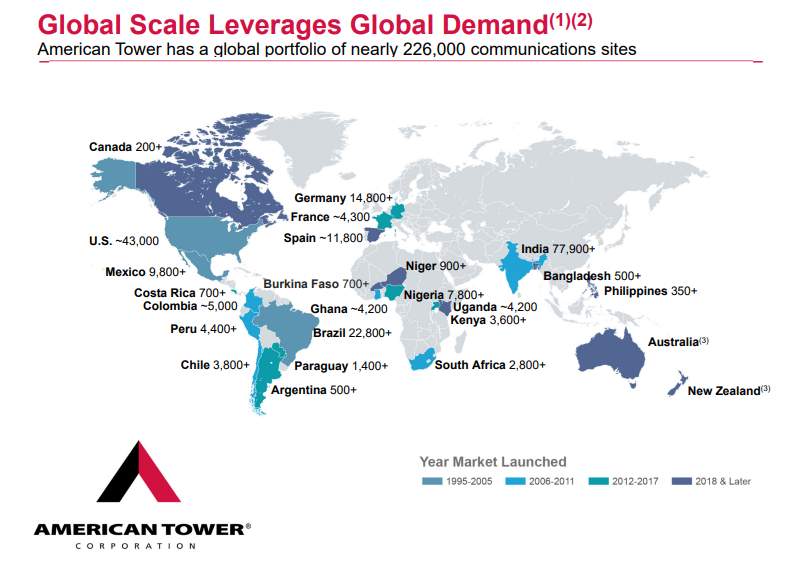 American Tower also operates a portfolio of 28 data centers across eight different markets in the US.
American Tower also operates a portfolio of 28 data centers across eight different markets in the US.
We have a pretty simple business model here.
American Tower erects, then rents out vertical antenna sites to service providers.
Service providers sign multiyear leases in order to access towers and install their equipment.
This equipment is necessary to carry out services such as telephony, mobile data, radio, and broadcast television.
In addition, after the acquisition of CoreSite Realty Corporation in late 2021, American Tower owns and operates interconnected data center facilities.
American Tower expects this acquisition to enhance the value of its existing tower real estate through emerging edge computing opportunities.
Regardless of exactly how that plays out, 5G and IoT are converging to make American Tower’s infrastructure more necessary and important than ever before.
I say that because of increasing data consumption and the importance of latency.
I’ll give you a quick example of what this looks like.
An average smartphone user might consume somewhere around 10 gigabytes per month in mobile data.
On the other hand, a self-driving car, for example, is thought to use somewhere around 4 terabytes of data per day.
Not only that, a self-driving car requires low latency for data accuracy, which would make, say, space-based Internet delivery difficult to realize in the real world.
We’re talking about orders of magnitude increases in data consumption.
Of course, self-driving cars won’t be populating cities tomorrow, and it’s an extreme example, but auto infotainment systems, which already consume a lot of data, have arrived.
And the way in which our various everyday devices are becoming more interconnected (i.e., IoT) translates into escalating demand for access to high-speed data in absolute terms across society.
Furthermore, American Tower has a unique advantage built right into the business model.
It domes down to the way in which its real estate can be easily leveraged, and this is unlike any other kind of real estate.
Once a tower is built, there is a lot of available scalability in terms of bringing on additional tenants.
Each tower is a bit of a compounding money machine for American Tower: Adding tenants, equipment, and upgrades results in much higher returns per tower, as revenue is added with minimal incremental cost.
That is what you might call the “secret sauce” for the business.
When you have thousands of these compounding money machines built out across the world, it’s not hard to imagine how the entire enterprise has become a compounding money machine.
That shows up in American Tower’s revenue, profit, and dividend.
Dividend Growth, Growth Rate, Payout Ratio and Yield
To date, the company has increased its dividend for 13 consecutive years.
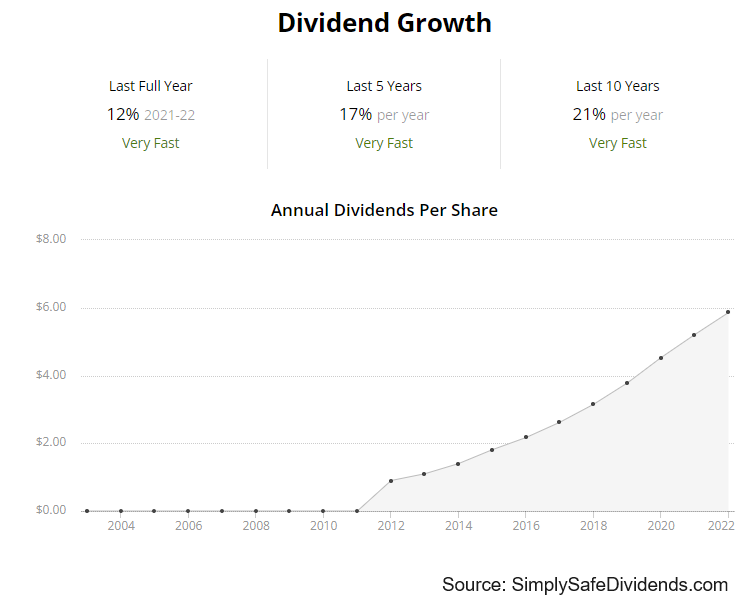 And what a blistering start American Tower has gotten off to, with its 10-year dividend growth rate of 20.3% blowing pretty much every other REIT out of the water.
And what a blistering start American Tower has gotten off to, with its 10-year dividend growth rate of 20.3% blowing pretty much every other REIT out of the water.
It’s highly unusual to see a REIT grow a dividend that fast, as REITs are primarily slow-growth income plays.
That said, because of the unique growth profile, American Tower’s stock has historically featured a relatively light yield.
But not now.
Largely because of the stock’s near-50% drawdown from its all-time high, reached in 2021, the yield has risen to 4%.
That’s nearly twice as high as the stock’s own five-year average yield of 2.1%.
Now, the stock has fallen on the back of macroeconomic concerns, as well as worries about a slowdown in growth.

What this market recalibration has done is, it’s raised the yield in order to compensate for any possible drop in growth.
However, the current dividend is still 10.2% higher than it was one year ago, indicating that there’s still plenty of growth in the tank here.
And with the payout ratio sitting at 66.8%, based on midpoint guidance for this year’s AFFO/share, the dividend remains a healthy one.
This is a rare REIT that features both high growth and a relatively high yield, meaning all kinds of dividend growth investors could be satisfied by what’s being offered.
Revenue and Earnings Growth
As satisfying as these metrics may be, many of them are looking into the past.
However, investors must be oriented toward the future, as today’s capital is being risked for the rewards of tomorrow.
As such, I’ll now build out a forward-looking growth trajectory for the business, which will be of great importance when the time comes later to estimate fair value.
I’ll first show you what the business has done over the last decade in terms of its top-line and bottom-line growth.
I’ll then reveal a professional prognostication for near-term profit growth.
Lining up the proven past with a future forecast in this way should allow us to roughly gauge what the future growth path of the business might look like.
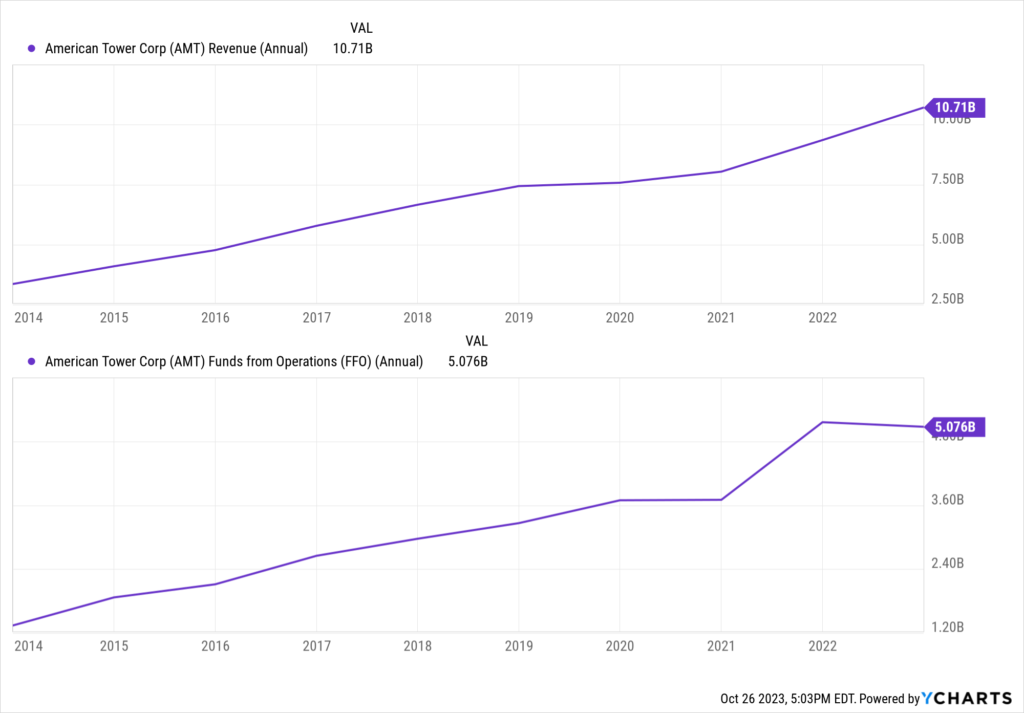 American Tower moved its revenue from $3.4 billion in FY 2013 to $10.7 billion in FY 2022.
American Tower moved its revenue from $3.4 billion in FY 2013 to $10.7 billion in FY 2022.
That’s a compound annual growth rate of 13.6%.
Excellent top-line growth, obviously.
However, when it comes to REITs, it’s imperative to look at profit growth on a per-share basis.
That’s because REITs use debt and equity to fund growth, as they’re legally required to distribute at least 90% of their taxable earnings to shareholders.
This circles back around to the point I made on REITs being income plays, and the limitations around internal funding for growth means tapping equity (by issuing shares) results in dilution.
That tends to create distortion between absolute revenue growth and profit growth relative to shares outstanding.
Also, when assessing profit for a REIT, we want to use funds from operations instead of normal earnings.
FFO (or adjusted FFO) is a measure of cash generated by a REIT, which adds depreciation and amortization expenses back to earnings.
American Tower’s AFFO/share grew from $3.68 to $10.12 over this period, which is a CAGR of 11.9%.
Not quite as impressive as revenue growth, and the 16% increase in the outstanding share count over this period definitely acted as a headwind.
Still, we can clearly see a business that is posting up double-digit growth.
For a REIT, this is actually quite prolific.
Looking forward, CFRA currently does not have a three-year AFFO/share growth projection for American Tower.
It’s unfortunate, as I do like to line up the proven past with a future forecast.
However, I think this passage from CFRA sums things up nicely: “[American Tower] will likely benefit long term, in our view, from demand from U.S. wireless carriers as growth in mobile data traffic remains robust and new spectrum deployments take place.”
CFRA also adds this: “We are optimistic about long-term demand driven by mobile video growth, unlimited data plans, and buildouts in mid-specturm 5G bands. International markets pose the greatest growth opportunity for [American Tower] moving forward, by our analysis. 4G penetration remains moderate in many international markets such as Latin America (currently about 50%) and Africa (around 15%). [American Tower] will continue investing significantly in these regions through both tower acquisitions and new builds, in our view.”
So we have long-term growth drivers in place (continued buildouts of infrastructure in places that lack it), supported by solid, ongoing demand for what’s already in place (because of mobile data traffic growth).
That’s a pretty nice setup for American Tower.
It’s more of the same, and the same is already great.
American Tower’s own guidance for FY 2023 is basically calling for a flat year, and some consolidation after a brisk run is not concerning.
I see quite a bit of wiggle room for American Tower in terms of its growth, as the market has already discounted less business growth and adjusted share pricing downward.
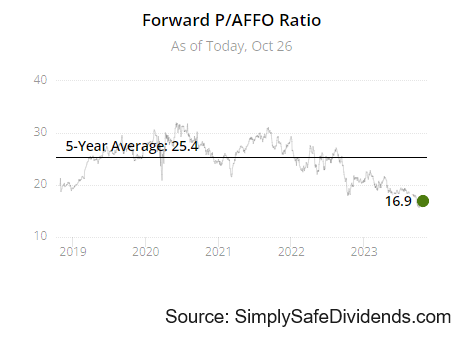 If American Tower can just grow its AFFO/share and dividend at just a high-single-digit rate from here – well below long-term tends – that would still be enough to make sense of an investment, due to the fact that the yield is nearly twice as high as it has been.
If American Tower can just grow its AFFO/share and dividend at just a high-single-digit rate from here – well below long-term tends – that would still be enough to make sense of an investment, due to the fact that the yield is nearly twice as high as it has been.
The stock offers REIT-like yield with compounder-like growth, which is awfully appealing.
Financial Position
Moving over to the balance sheet, American Tower has a good financial position for a REIT.
There is $67.2 billion in total assets against $54.8 billion in total liabilities.
American Tower’s credit ratings are in investment-grade territory (albeit at the low end): BBB-, S&P; BBB+, Fitch; Baa3, Moody’s.
Another common measure for a REIT’s financial position is the net debt/EBITDA ratio, which is 5.4 for American Tower (as of the end of the last full fiscal year).
This is fairly standard.
I typically see REITs range from 3 to 7 on this ratio, which would put American Tower somewhere in the middle.
I’d prefer to see something lower – say, around 3 or 4 – but I’m not troubled by this number.
American Tower isn’t putting up the blistering growth it used to, but it’s still a top-shelf REIT benefiting from a long demand runway for its infrastructure.
And with economies of scale, switching costs, and entrenched infrastructure, the company does benefit from durable competitive advantages.
Of course, there are risks to consider.
Litigation, regulation, and competition are omnipresent risks in every industry.
A REIT’s capital structure relies on external funding for growth, which exposes the company to volatile capital markets (through equity issuances) and interest rates (through debt issuances).
Adding to the rate conversation, higher rates can hurt this particular business model twice over: Debt becomes more expensive to take on and service, and equity can become more expensive (because income-sensitive investors have alternatives, which puts downward pressure on the stock price).
American Tower’s international footprint offers more growth opportunities, but it also exposes the company to currency exchange fluctuations, idiosyncratic market dynamics, and geopolitics.
Customer concentration is a risk, as three major telecommunications companies account for over half of the company’s revenue.
American Tower’s massive scale is an advantage, but it also introduces questions around future growth and the law of large numbers.
LEO satellites present a technological risk, as the possible viability of LEO satellites as an antenna alternative in the future could make towers obsolete.
Most of these risks are common for a REIT, yet this REIT has been anything but common for a long time now.
And the current valuation, after a severe correction in the stock’s price, is also uncommon…
Stock Price Valuation
The forward P/AFFO ratio is 16.7.
That is very low relative to the growth that American Tower has been putting up.
For a REIT that has enjoyed lofty multiples for years, this is a major fall from grace.
The P/CF ratio of 17.2 is well off of the stock’s own five-year average P/CF ratio of 25.7.
And the yield, as noted earlier, is significantly higher than its own recent historical average.
So the stock looks cheap when looking at basic valuation metrics. But how cheap might it be? What would a rational estimate of intrinsic value look like?
I valued shares using a dividend discount model analysis.
I factored in a 10% discount rate and a long-term dividend growth rate of 6.5%.
While that may be slightly high for what I’d usually allow for when dealing with a REIT, it’s actually on the low end of what I ordinarily allow for in a general model.
I’m accounting for the unusual quality and growth that American Tower has demonstrated over a sustained period of time, which has bled down into outstanding dividend growth.
However, I’m also acknowledging the inherent issues that plague REITs, including consistent debt issuances and equity dilution.
I really do believe that American Tower can make good on this level of dividend growth, at least, which would actually be quite the comedown from American Tower’s remarkable past.
The payout ratio remains reasonable, and recent dividend raises have been encouraging.
I like to err on the side of caution, and I’d argue I’m doing just that here.
The DDM analysis gives me a fair value of $197.18.
The reason I use a dividend discount model analysis is because a business is ultimately equal to the sum of all the future cash flow it can provide.
The DDM analysis is a tailored version of the discounted cash flow model analysis, as it simply substitutes dividends and dividend growth for cash flow and growth.
It then discounts those future dividends back to the present day, to account for the time value of money since a dollar tomorrow is not worth the same amount as a dollar today.
I find it to be a fairly accurate way to value dividend growth stocks.
I think I put together a pretty modest model, yet the stock still comes out looking quite cheap.
But we’ll now compare that valuation with where two professional stock analysis firms have come out at.
This adds balance, depth, and perspective to our conclusion.
Morningstar, a leading and well-respected stock analysis firm, rates stocks on a 5-star system.
1 star would mean a stock is substantially overvalued; 5 stars would mean a stock is substantially undervalued. 3 stars would indicate roughly fair value.
Morningstar rates AMT as a 4-star stock, with a fair value estimate of $225.00.
CFRA is another professional analysis firm, and I like to compare my valuation opinion to theirs to see if I’m out of line.
They similarly rate stocks on a 1-5 star scale, with 1 star meaning a stock is a strong sell and 5 stars meaning a stock is a strong buy. 3 stars is a hold.
CFRA rates AMT as a 4-star “BUY”, with a 12-month target price of $215.00.
As you can see, I did come out low. Perhaps I was being too cautious. Averaging the three numbers out gives us a final valuation of $212.39, which would indicate the stock is possibly 24% undervalued.
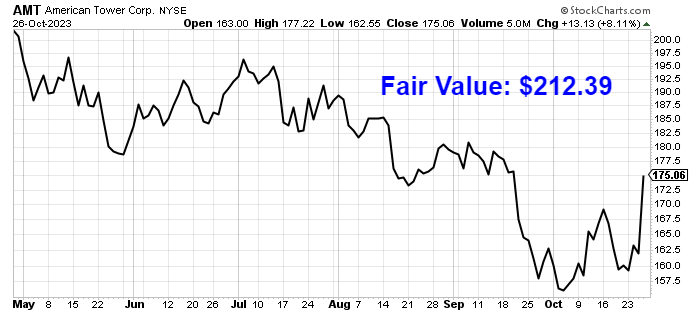 Bottom line: American Tower Corp. (AMT) is a unique REIT that should benefit from rising demand for mobile data and the infrastructure required to make sure that high-speed mobile data can be delivered. With a market-smashing yield, a reasonable payout ratio, double-digit dividend growth, more than 10 consecutive years of dividend increases, and the potential that shares are 24% undervalued, deal-seeking dividend growth investors looking for a rare combination of yield and growth from a REIT ought to have their eyes on this name.
Bottom line: American Tower Corp. (AMT) is a unique REIT that should benefit from rising demand for mobile data and the infrastructure required to make sure that high-speed mobile data can be delivered. With a market-smashing yield, a reasonable payout ratio, double-digit dividend growth, more than 10 consecutive years of dividend increases, and the potential that shares are 24% undervalued, deal-seeking dividend growth investors looking for a rare combination of yield and growth from a REIT ought to have their eyes on this name.
-Jason Fieber
P.S. If you’d like access to my entire six-figure dividend growth stock portfolio, as well as stock trades I make with my own money, I’ve made all of that available exclusively through Patreon.
Note from D&I: How safe is AMT’s dividend? We ran the stock through Simply Safe Dividends, and as we go to press, its Dividend Safety Score is 78. Dividend Safety Scores range from 0 to 100. A score of 50 is average, 75 or higher is excellent, and 25 or lower is weak. With this in mind, AMT’s dividend appears Safe with an unlikely risk of being cut. Learn more about Dividend Safety Scores here.
Source: Dividends & Income

